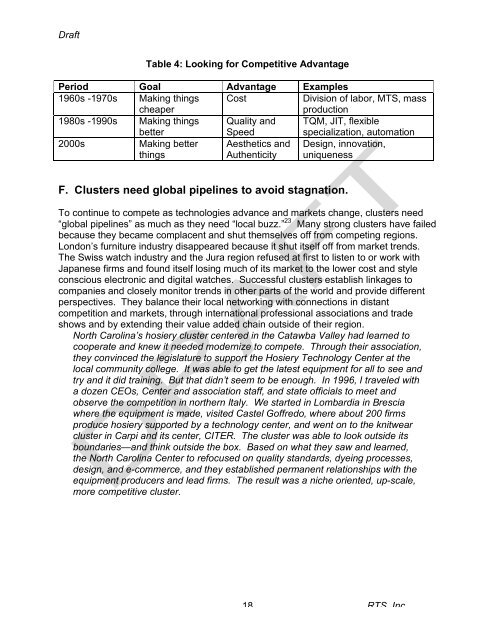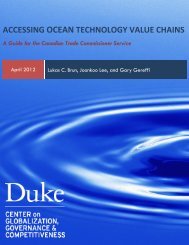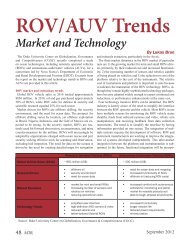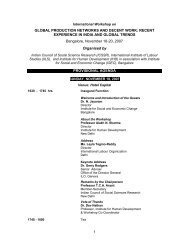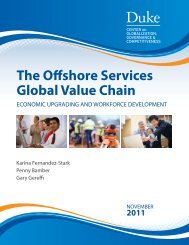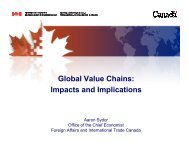Paper - Center on Globalization, Governance & Competitiveness
Paper - Center on Globalization, Governance & Competitiveness
Paper - Center on Globalization, Governance & Competitiveness
Create successful ePaper yourself
Turn your PDF publications into a flip-book with our unique Google optimized e-Paper software.
Draft<br />
Table 4: Looking for Competitive Advantage<br />
Period Goal Advantage Examples<br />
1960s -1970s Making things Cost Divisi<strong>on</strong> of labor, MTS, mass<br />
cheaper<br />
producti<strong>on</strong><br />
1980s -1990s Making things Quality and TQM, JIT, flexible<br />
better<br />
Speed specializati<strong>on</strong>, automati<strong>on</strong><br />
2000s Making better Aesthetics and Design, innovati<strong>on</strong>,<br />
things<br />
Authenticity uniqueness<br />
F. Clusters need global pipelines to avoid stagnati<strong>on</strong>.<br />
To c<strong>on</strong>tinue to compete as technologies advance and markets change, clusters need<br />
“global pipelines” as much as they need “local buzz.” 23 Many str<strong>on</strong>g clusters have failed<br />
because they became complacent and shut themselves off from competing regi<strong>on</strong>s.<br />
L<strong>on</strong>d<strong>on</strong>’s furniture industry disappeared because it shut itself off from market trends.<br />
The Swiss watch industry and the Jura regi<strong>on</strong> refused at first to listen to or work with<br />
Japanese firms and found itself losing much of its market to the lower cost and style<br />
c<strong>on</strong>scious electr<strong>on</strong>ic and digital watches. Successful clusters establish linkages to<br />
companies and closely m<strong>on</strong>itor trends in other parts of the world and provide different<br />
perspectives. They balance their local networking with c<strong>on</strong>necti<strong>on</strong>s in distant<br />
competiti<strong>on</strong> and markets, through internati<strong>on</strong>al professi<strong>on</strong>al associati<strong>on</strong>s and trade<br />
shows and by extending their value added chain outside of their regi<strong>on</strong>.<br />
North Carolina’s hosiery cluster centered in the Catawba Valley had learned to<br />
cooperate and knew it needed modernize to compete. Through their associati<strong>on</strong>,<br />
they c<strong>on</strong>vinced the legislature to support the Hosiery Technology <str<strong>on</strong>g>Center</str<strong>on</strong>g> at the<br />
local community college. It was able to get the latest equipment for all to see and<br />
try and it did training. But that didn’t seem to be enough. In 1996, I traveled with<br />
a dozen CEOs, <str<strong>on</strong>g>Center</str<strong>on</strong>g> and associati<strong>on</strong> staff, and state officials to meet and<br />
observe the competiti<strong>on</strong> in northern Italy. We started in Lombardia in Brescia<br />
where the equipment is made, visited Castel Goffredo, where about 200 firms<br />
produce hosiery supported by a technology center, and went <strong>on</strong> to the knitwear<br />
cluster in Carpi and its center, CITER. The cluster was able to look outside its<br />
boundaries—and think outside the box. Based <strong>on</strong> what they saw and learned,<br />
the North Carolina <str<strong>on</strong>g>Center</str<strong>on</strong>g> to refocused <strong>on</strong> quality standards, dyeing processes,<br />
design, and e-commerce, and they established permanent relati<strong>on</strong>ships with the<br />
equipment producers and lead firms. The result was a niche oriented, up-scale,<br />
more competitive cluster.<br />
18<br />
RTS, Inc.


